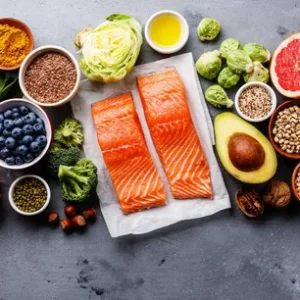Say Goodbye to Loose Skin: How to Prevent Loose Skin While Losing Weight
The Fear of Loose Skin
Losing weight is one of the most empowering journeys you can embark on, but it doesn’t come without its challenges. While the scale dropping and the progress in your health feel rewarding, many of us share a concern that’s just as real: loose skin. The fear of sagging skin after weight loss can sometimes be enough to make people hesitant to start or continue their weight loss journey.
I still remember how excited I was when I hit a milestone in my weight loss journey, only for my mind to spiral as I wondered, “What about my skin?” After working hard to shed pounds, the last thing I wanted was for sagging skin to overshadow all my hard work. If this sounds like something you’ve feared, you’re definitely not alone. But here’s the good news: with the right approach, it’s possible to prevent loose skin or minimize its appearance, and you don’t have to sacrifice your health and fitness goals to achieve that.
In this post, I’ll walk you through practical tips, personal insights, and essential advice to help you prevent loose skin while losing weight. Let’s get started on this transformative journey—skin and all!
Understanding Skin Elasticity: Why Loose Skin Happens
Before diving into solutions, it’s essential to understand what causes loose skin in the first place. Understanding skin elasticity and how it changes when we lose weight will give you the knowledge to take better care of your skin throughout your weight loss process.
What Is Skin Elasticity?
Your skin is a remarkable organ with an ability to stretch and contract. Think of it like a rubber band—it can stretch to accommodate changes, but over time, it may lose its ability to snap back as effectively. When you lose weight, especially a significant amount, your skin might not be able to shrink back quickly enough to match your new body shape, leaving behind sagging or loose skin.
As we age, our skin naturally loses some of its elasticity, which makes it more difficult for the skin to tighten up after weight loss. Genetics also play a big role in how well your skin bounces back. Some people are genetically predisposed to better skin elasticity, while others may struggle more with loose skin, regardless of their weight loss method.
Factors That Affect Skin Elasticity
There are several key factors that affect how well your skin reacts to weight loss:
- Age: As you age, the production of collagen and elastin—two proteins crucial for skin elasticity—slows down, making it harder for your skin to tighten.
- Genetics: Your genetic makeup plays a significant role in how well your skin adapts to weight loss. If your parents had good skin elasticity, you may be more likely to experience similar results.
- Amount and Speed of Weight Loss: Rapid weight loss (especially over a short period) increases the risk of developing loose skin. Losing weight too quickly doesn’t give the skin enough time to adjust.
- Skin Health: People who take care of their skin with proper hydration, sun protection, and moisturizing may experience better skin elasticity compared to those who neglect skin health.
How to Prevent Loose Skin While Losing Weight
The good news is that there are steps you can take to reduce the appearance of loose skin and improve skin elasticity during your weight loss journey. It all comes down to lifestyle changes, strength training, proper nutrition, and patience.
1. Lose Weight Gradually
The key to preventing loose skin is slow and steady progress. While the idea of rapid weight loss may seem tempting, losing weight too quickly can place undue stress on your skin, making it more difficult for it to bounce back. Gradual weight loss gives your skin time to shrink with your body, reducing the likelihood of sagging.
Why Gradual Weight Loss Matters
When you lose weight too quickly, your skin is forced to adapt much faster than it can naturally. In contrast, gradual weight loss provides more time for your skin to shrink with you. The American Academy of Dermatology recommends aiming for about 1–2 pounds of weight loss per week to avoid straining the skin and to give your body a chance to adjust healthily.
Gradual weight loss allows your skin to make the adjustments it needs to remain firm. When you lose weight too quickly, your skin doesn’t have time to recover and adapt. The skin is stretched over the body, and once the fat underneath starts to decrease rapidly, the skin may struggle to keep up, resulting in sagging.
2. Hydrate, Hydrate, Hydrate
One of the simplest yet most effective ways to maintain skin elasticity is hydration. Your skin requires moisture to stay firm and elastic, and when you’re dehydrated, your skin can become dry, tight, and more prone to sagging.
How Hydration Affects Skin Elasticity
When you’re properly hydrated, your skin retains its natural plumpness, and elasticity is preserved. Hydration is essential for the production of collagen and elastin—two proteins that keep your skin strong and elastic. Aim to drink at least 8 glasses of water a day to keep your skin hydrated, and make sure to consume foods rich in water like cucumbers, oranges, and watermelon.
When your skin is well-hydrated, it has a better chance of adjusting to the changes that come with weight loss. If you’re dehydrated, the skin can become dull, dry, and more prone to sagging, making the appearance of loose skin more noticeable.
3. Strength Training: The Best Defense Against Loose Skin
Strength training is arguably the most effective way to prevent loose skin during weight loss. When you build muscle, it not only helps you burn fat more effectively, but it also provides structure to your body, which can prevent your skin from sagging.
Why Muscle Matters for Skin Firmness
When you lose weight, the fat underneath your skin decreases, which can leave your skin with less support. By building muscle, you create a solid foundation that helps support the skin, preventing it from sagging. Additionally, muscle development increases collagen production, which improves skin elasticity and firmness.
Muscle helps fill in the space left behind by lost fat, preventing your skin from sagging or hanging loosely. Moreover, strength training helps improve circulation, which nourishes the skin and promotes its elasticity.
Tip: Incorporate strength training into your routine 3–4 times per week. Focus on compound exercises like squats, lunges, push-ups, and deadlifts to target multiple muscle groups. These exercises are particularly effective at building overall muscle and tightening your body. Aim for a mix of upper and lower body workouts to create balance and symmetry in your physique.
4. Prioritize Skin-Healthy Nutrition
What you eat plays a huge role in your skin’s ability to adjust to weight loss. The right nutrients can help improve your skin’s elasticity, so it’s crucial to fuel your body with foods that nourish and support skin health.
Key Nutrients for Skin Health
- Collagen: Collagen is the protein that keeps your skin firm and elastic. To support collagen production, incorporate collagen-rich foods like bone broth, fish, chicken, and egg whites into your diet. Collagen supplements are also popular for their ability to promote skin regeneration and elasticity.
- Vitamin C: This vitamin is essential for collagen production, which is key for maintaining healthy skin. Foods rich in vitamin C, such as citrus fruits, strawberries, bell peppers, and broccoli, will support your skin’s ability to tighten and adjust to weight loss. Vitamin C also helps protect the skin from damage caused by free radicals, which can weaken skin structure over time.
- Omega-3 Fatty Acids: Healthy fats help keep your skin hydrated and smooth. Foods like salmon, avocado, and walnuts are great sources of omega-3 fatty acids. These fats help reduce inflammation and improve skin elasticity. Additionally, omega-3 fatty acids support the skin’s natural barrier function, which helps keep moisture locked in and prevents dryness.
- Amino Acids: Amino acids like glycine and proline are critical for collagen production. These amino acids are found in protein-rich foods like lean meats, fish, eggs, and legumes. They work together to support the repair and regeneration of skin tissue, keeping it firm and resilient.
Bonus Tip: Eating a diet rich in antioxidants can help protect your skin from damage. Foods like blueberries, spinach, and green tea can help combat oxidative stress, which accelerates skin aging and weakens elasticity.
Check out this article for more information fruits to go for while maintaining your fitness routine.
5. Take Care of Your Skin: Moisturize and Exfoliate
Taking care of your skin on the outside is just as important as nourishing it from the inside. Regular moisturizing helps keep your skin hydrated, and exfoliating can promote the growth of new skin cells, which can help tighten loose skin over time.
The Power of Skin Care
Look for moisturizers with ingredients like vitamin E, hyaluronic acid, and aloe vera, which are known for their skin-tightening properties. Vitamin E is particularly beneficial for healing skin, while hyaluronic acid helps retain moisture and keep skin plump. Aloe vera is soothing and promotes collagen production, which can aid in skin tightening.
Regularly exfoliating with a gentle scrub can also help stimulate collagen production and improve circulation, which is essential for skin regeneration. Exfoliating helps remove dead skin cells, revealing fresher, younger skin underneath. It also helps improve blood flow, which nourishes the skin and supports its elasticity.
What to Do If You’re Left with Loose Skin
Even if you follow all of the above tips, it’s possible that loose skin may remain, especially if you’ve lost a significant amount of weight. But don’t worry; there are still options to help you tighten up and feel more confident in your skin.
1. Non-Surgical Treatments for Tightening Skin
There are several non-invasive treatments that can help tighten skin and improve elasticity:
- Laser Therapy: Laser treatments stimulate collagen production, which can help tighten skin. Laser therapy can target the deeper layers of the skin, where collagen production occurs, to promote skin regeneration and tightening.
- Radiofrequency Therapy: This treatment uses heat to encourage collagen production and tighten the skin. The heat stimulates the collagen fibers, causing them to contract and tighten the skin.
- Ultrasound Therapy: Uses sound waves to stimulate deeper layers of skin, promoting collagen and elastin production. Ultrasound therapy is non-invasive and can be used to treat loose skin on various areas of the body.
These treatments can be effective for people who have lost a moderate amount of weight and want to avoid surgery.
2. Surgical Solutions for Excess Skin
In cases where loose skin is more severe, surgical procedures like a tummy tuck or body lift might be necessary to remove excess skin and give you a firmer appearance. These procedures are typically reserved for individuals who have lost a large amount of weight and have excess skin that doesn’t respond to non-surgical treatments.
Conclusion: Embrace the Journey
Losing weight is an incredible accomplishment, and while the fear of loose skin is valid, it doesn’t have to stop you from reaching your health and fitness goals. By focusing on gradual weight loss, staying hydrated, building muscle, and caring for your skin, you can minimize the risk of loose skin and keep your skin firm and elastic.
Remember, the journey isn’t about achieving perfection; it’s about progress. Be kind to yourself, and embrace each step of the process, knowing that your efforts will pay off in the long run. You’ve got this!
Have you struggled with loose skin while losing weight? Share your experiences and tips in the comments below. Let’s support each other on this transformative journey!
Check out this article on how to prevent loose skin.
FAQs
- Can I completely prevent loose skin while losing weight?
While it’s difficult to completely prevent loose skin, following the steps outlined in this post—like losing weight gradually, staying hydrated, and building muscle—can greatly reduce its appearance.
- How long does it take for skin to tighten after weight loss?
It can take several months for skin to adjust and tighten after weight loss, depending on factors like age, genetics, and the amount of weight lost.
- Does strength training help prevent loose skin?
Yes, strength training can significantly help prevent loose skin by building muscle, which provides support and helps tighten the skin as you lose weight.
- What foods are best for improving skin elasticity?
Foods rich in collagen, vitamin C, and omega-3 fatty acids—such as bone broth, citrus fruits, and salmon—can help improve skin elasticity.
- Are there non-surgical options for tightening loose skin?
Yes, treatments like laser therapy, radiofrequency therapy, and ultrasound therapy can help tighten loose skin without surgery.






